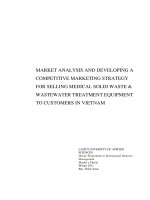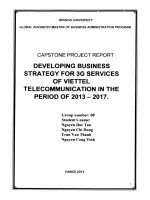MARKETING STRATEGY FOR MEDICAL DEVICES MARKET
Bạn đang xem bản rút gọn của tài liệu. Xem và tải ngay bản đầy đủ của tài liệu tại đây (2.79 MB, 110 trang )
VYSOKÉ UČENÍ TECHNICKÉ V BRNĚ
BRNO UNIVERSITY OF TECHNOLOGY
FAKULTA PODNIKATELSKÁ
ÚSTAV MANAGEMENTU
FACULTY OF BUSINESS AND MANAGEMENT
INSTITUTE OF MANAGEMENT
MARKETING STRATEGY FOR MEDICAL DEVICES
MARKET
MARKETINGOVÁ STRATEGIE PRO TRH ZDRAVOTNÍ TECHNIKY
DIPLOMOVÁ PRÁCE
MASTER’S THESIS
AUTOR PRÁCE
Bc. HANA COUFALOVÁ
AUTHOR
VEDOUCÍ PRÁCE
SUPERVISOR
BRNO 2011
Ing. VÍT CHLEBOVSKÝ, Ph.D.
ABSTRACT
The master‟s thesis is focused on a development of a marketing strategy for launching
products on a high competitive market of medical devices. To be more specific, it
focuses on a new product launch of an ablation catheter and a mapping system for
treating cardiology illnesses produced by an American company St. Jude Medical. The
thesis describes the launch in order to find critical points and optimize the entire
process.
ABSTRAKT
Tato diplomová práce je zaměřena na vývoj marketingové strategie pro zavedení
produktů na vysoce konkurečním trhu zdravotnických prostředků. Konkrétně se
zaměřuje na zavedení ablačního katetru a mapovacího zařízení pro léčbu srdečních
chorob, které vyrábí americká společnost St. Jude Medical. Práce popisuje zavedení na
trh, aby bylo možné najít kritické body a optimalizovat celý tento proces.
KEY WORDS
Marketing strategy, new product launch, international market, medical company, high
competitive market.
KLÍČOVÁ SLOVA
Marketingová strategie, zavedení nového produktu, mezinárodní trh, zdravotnická
společnost, vysoce konkurenční trh.
BIBLIOGRAPHIC CITATION
COUFALOVÁ, H. Marketing Strategy for Medical Devices Market. Brno: Brno
University of Technology, Faculty of Business and Management, 2011. 110 p.
Supervisor of the master‟s thesis Ing. Vít Chlebovský, Ph.D..
BIBLIOGRAFICKÁ CITACE
COUFALOVÁ, H. Marketingová strategie pro trh zdravotní techniky. Brno: Vysoké
učení technické v Brně, Fakulta podnikatelská, 2011. 110 s. Vedoucí diplomové práce
Ing. Vít Chlebovský, Ph.D..
STATUTORY DECLARATION
Herewith I declare that the submitted master‟s thesis is authentic and written
independently. I also pronounce that the citation of the resources used in this thesis is
complete and copyrights were not infringed (Act. No. 121/2000 Coll., on Copyright and
Rights Related to Copyright).
PROHLÁŠENÍ
Prohlašuji, že předložená diplomová práce je původní a zpracovala jsem ji samostatně.
Prohlašuji, že citace použitých pramenů je úplná, že jsem ve své práci neporušila
autorská práva (ve smyslu Zákona č. 121/2000 Sb., o právu autorském a o právem
sourisejících s právem autorským).
In Brno 25th May 2011
V Brně dne 25.května 2011
.........................................................
Signature (Podpis)
ACKNOWLEDGEMENT
Above all, I would like to thank to the supervisor of my master‟s thesis to
Ing. Vít Chlebovský, Ph.D., next to the employees of the company St. Jude Medical,
especially to Pablo Castrosin del Mazo and Kris D‟hulst, for willingness and assistance
with the elaboration of the thesis.
PODĚKOVÁNÍ
Ráda bych poděkovala zejména vedoucímu mé diplomové práce, kterým byl
Ing. Vít Chlebovský, Ph.D., a dále zaměstnancům společnosti St. Jude Medical, zvláště
Pablovi Castrosin del Mazo a Krisovi D‟hulst, za ochotu a pomoc při zpracování této
práce.
CONTENT
INTRODUCTION .............................................................................................. 10
AIM OF THE THESIS ...................................................................................... 11
1
THEORY ..................................................................................................... 12
1.1
MARKETING .................................................................................................. 12
1.2
INTERNATIONAL MARKETING ................................................................ 12
1.3
MARKETING STRATEGY ............................................................................ 14
1.3.1
Company Position in the Market .............................................................. 16
1.3.2
Competitive Strategies .............................................................................. 17
1.4
PLANNING PHASE ........................................................................................ 18
1.4.1
1.4.1.1
SWOT Analysis ................................................................................. 19
1.4.1.2
PEST Analysis ................................................................................... 19
1.4.2
Goal Setting, Product and Market Focus .................................................. 21
1.4.2.1
Segmentation and Targeting .............................................................. 22
1.4.2.2
Positioning ......................................................................................... 24
1.4.3
2
Situation Analysis ..................................................................................... 18
Marketing Plan .......................................................................................... 25
1.4.3.1
Marketing Mix ................................................................................... 26
1.4.3.2
Product Life Cycle ............................................................................. 37
1.4.3.3
Marketing Communications Budget.................................................. 38
1.5
IMPLEMENTATION PHASE ........................................................................ 39
1.6
CONTROL PHASE ......................................................................................... 40
1.6.1
Current Results – Evaluating, Interpreting and Improving....................... 41
1.6.2
Marketing Effectiveness Audit ................................................................. 42
COMPANY OVERVIEW .......................................................................... 43
2.1
ST. JUDE MEDICAL, INC. ............................................................................ 43
2.2
COMPANY DEVELOPMENT ....................................................................... 44
2.3
PRODUCTS ..................................................................................................... 45
2.4
FOCUS AREAS GROWTH ............................................................................ 46
2.4.1
Atrial Fibrillation ...................................................................................... 46
2.4.2
Cardiac Rhythm Management .................................................................. 47
2.4.3
Neuromodulation ...................................................................................... 48
2.4.4
Cardiovascular .......................................................................................... 48
2.5
3
COMPANY STRUCTURE ............................................................................. 49
ANALYTICAL PART................................................................................ 51
3.1
STRUCTURE OF BCC ................................................................................... 51
3.2
CARDIAC ABLATION .................................................................................. 52
3.3
PRODUCTS TO BE LAUNCHED ................................................................. 53
3.4
CREATION OF A NEW PRODUCT LAUNCH PLAN ................................. 53
3.4.1
Starting Point ............................................................................................ 55
3.4.2
Analysis Of The Current Situation ........................................................... 55
3.4.2.1
PEST Analysis ................................................................................... 57
3.4.2.2
SWOT Analysis ................................................................................. 61
3.4.2.3
Objectives .......................................................................................... 63
3.4.2.4
Segmentation and Targeting .............................................................. 64
3.4.2.5
Positioning ......................................................................................... 64
3.4.2.6
Messaging .......................................................................................... 65
3.4.3
3.4.3.1
Activities of Departments .................................................................. 68
3.4.3.2
Marketing Mix ................................................................................... 70
3.4.3.3
Medical Device Life Cycle ................................................................ 75
3.4.3.4
NPL Budget ....................................................................................... 76
3.4.4
4
Marketing Launch Plan ............................................................................. 66
Implementation and Control Phase ........................................................... 76
STRATEGY PROPOSAL.......................................................................... 78
4.1
CRITICAL POINTS ........................................................................................ 78
4.1.1
Marketing/Marcom ................................................................................... 79
4.1.1.1
Marketing Management..................................................................... 79
4.1.1.2
Marketing .......................................................................................... 80
4.1.1.3
Marcom.............................................................................................. 81
4.1.2
Education .................................................................................................. 81
4.1.3
Clinical ...................................................................................................... 82
4.1.4
Legal, Regulatory, Quality Affairs & Business Development ................. 82
4.1.4.1
Legal .................................................................................................. 82
4.1.4.2
Regulatory ......................................................................................... 82
4.1.5
Operations/Capital Equipment Service ..................................................... 83
4.1.5.1
Operations.......................................................................................... 83
4.1.5.2
Service ............................................................................................... 84
4.2
PROPOSITIONS.............................................................................................. 85
4.3
FORECASTED COSTS AND GAINS ............................................................ 89
CONCLUSION ................................................................................................... 93
REFERENCES ................................................................................................... 95
LIST OF USED ABBREVIATIONS ................................................................ 99
LIST OF APPENDIXES.................................................................................. 100
APPENDIXES .................................................................................................. 100
INTRODUCTION
In today‟s market, it is very important to have a good and detailed marketing to be
able to succeed. Every marketing plan is different depending on the product, the
company and the situation on the market. Everybody who attended at least a basic
marketing course should be able to imagine what would be a marketing plan like for
consumers‟ good, e.g. clothes or food. However, the creating of a marketing plan for
medical devices, which are high-tech and specialized products sold on a high
competitive market, can be more challenging.
The master‟s thesis is based on the author‟s experience gained during her
internship at the Atrial Fibrillation marketing department of the EMEAC (Europe,
Middle East, Africa, Canada) Headquarters of the American company St. Jude Medical
in Brussels. The author participated on the creation and implementation of the new
product launch plan there and found out that in the process is still a space for
improvement. Due to that the author chose the topic Marketing Strategy for Medical
Devices Market and set the aim of the thesis to optimize a launch plan strategy.
The aim will be achieved by three separate but related steps. The first step is to
describe the creation of the launch plan for the European Union market. The creation of
the plan is the responsibility of the Atrial Fibrillation marketing manager who works for
the EMEAC Headquarters in Brussels. The second step is to carry out an analysis of the
entire process of creation and implementation of the launch plan in order to identify
critical steps that have to be ensured to avoid delays or cancellations of the launch. The
final step leading to optimization of the process is to propose improvements of the
product launch within the European Union and specify the forecasted costs and gains of
the suggested solutions.
The creation of the marketing plan of medical devices is very important and
complex issue. St. Jude Medical launches more than forty products per year and that is
the reason why it is important for them to continually improve and adapt the process to
constantly changing conditions on markets. The thesis will help the company to realize
the important steps during the launch procedure and propose possible solutions for
current problems that can also occur in the future if they are not taken care of.
10
AIM OF THE THESIS
The aim of the master‟s thesis is to optimize a launch plan strategy on the
European Union market for products of the Atrial Fibrillation portfolio of the American
company St. Jude Medical.
The applied methods that will help to achieve the above mentioned aim are the
analysis of the external environment (the PEST analysis), the analysis of the internal
environment (the SWOT analysis) and the Four Ps Framework (Product, Price, Place,
Promotion). All these methods are described in a greater detail in the theoretical part of
the thesis.
11
1
THEORY
1.1
MARKETING
Marketing is a very quickly developing discipline and that is why it is very
important for a company to be flexible enough in following new trends, which can
change from day to day, and following customer needs, which are gradually higher and
higher.
In the old times, the economy was based on the Industrial Revolution, on
managing manufacturing industries and the business was limited by political and trade
barriers. Contrary to the industrial society, today‟s post-industrial economy has
witnessed “the digital revolution” where the management of information about
customers, products, prices, competitors, and every other aspect of the marketing
environment has come to play a vital role. The data is being analyzed in a very short
period of time and business is being done on the global market place. The revolution
has placed also a whole new set of capabilities in the hands of consumers and
businesses – such as a substantial increase in buying power (price and product attributes
comparison, purchase making), a greater variety of available goods and services,
information about practically anything or placing and receiving orders anywhere.
Today‟s marketing goal is not only to increase market share, profitability or gain
further customers at the expense of the direct competition, but also to have a long-term
strategic development based for example on a strategic partnerships developed on an
international level. Regarding the medical industry, it is very important to maintain
good relationships with customers – so-called relationship marketing, which is a part of
Customer Relationship Management. This helps to create a series of one-to-one, longterm, profitable relationships between a company and its customers. (16, 20)
1.2
INTERNATIONAL MARKETING
“International marketing is a business philosophy focused on satisfying the needs
and wishes of customers in international markets. The main goal of an international
marketing strategy is to create maximum value for stakeholders by optimizing a firm‟s
12
resources and searching for advantageous business opportunities in foreign markets.”
(20, s. 8)
International marketing has some features in common with the domestic
marketing however there many specifics that have to be taken into consideration when
choosing a marketing strategy. These specifics can become a great advantage and bring
lots of new opportunities or can become a threat for a company. Some of the specifics,
which the international marketers have to face, are listed below:
- legislation;
- regulation;
- trade and political barriers;
- conditions for business activities of foreign companies;
- global marketing network;
- strategic alliances;
- social and cultural differences and their influence on the behavior and
decisions of customers;
- a good quality survey of new foreign markets is difficult;
- preference of domestic products and producers;
- organization of the foreign markets
- problems with entering distribution channels;
- adapting the marketing mix;
- working in and unfamiliar environment
- facing different lifestyle;
- language barriers and other. (20, s. 9)
On the one hand, going across borders brings many new opportunities, which can
generate profit, if a company is successful. It can as well help to diversify the risks. A
company is then no longer dependant only on one market and that brings certain
flexibility in decision-making. That is why going international can be also used as a tool
of risk management.
13
On the other hand, international marketing faces many various risks. A company
should try to minimize the risks as much as it can but from the obvious reasons
connected to the national markets differences listed above, it can never completely
avoid them. Among the risks, we can define:
- Political risks (nationalization and monetary restrictions, war, strikes,
terrorism, natural disasters);
- transfer risks (money transfer disturbed by government by freezing the money
outflow from the economy);
- country risks (stability of a country, macroeconomic changes);
- commercial risks (reliable business partner in foreign country);
- financial risks (exchange rate risks, interest risks). (20)
1.3
MARKETING STRATEGY
A strategy in general is a plan about how to get from one place to the other
desired place. However, no plan can be developed without a proper preparation. First, a
company has to realize where it is now and where does it want to go in the future. For
management this means taking strategic decisions about the company‟s mission and the
width of its domain (e.g. types of industries, product lines). Knowing the starting point
and the final point allows a company to think about how to get there. The choice of the
ways to get to the final point can be limited by financial and human resources and that is
the reason why a company needs to know how to obtain and allocate its resources.
Another important factor of success of the plan is to know how a company will compete
with its competitors and how it can position itself to get a sustainable advantage. Having
the research done and the plan developed a company can start translating the plans into
actions. To see if the plan is working well a company should control the results of the
implementation in comparison with its plans and eventually make some corrections to
the original plan.
The same approach is used in a strategic marketing process although it goes more
into detail. A company allocates its marketing mix resources to reach its target markets.
14
This process consists of three main phases: the planning, implementation, and control
phase. (For more information see picture nb. 1).
Corporate
objectives and
strategy
External
environment
Business-level
objectives and
strategy
Market opportunity analysis
- Environmental and competitor analysis
- Industry dynamics
- Customer analysis, segmentation and targeting decisions
- Positioning decisions
Formulating strategies for specific market situations
- Strategies for new market entries
- Strategies for growth markets
- Strategies for mature and declining markets
- Global marketing strategies
Implementation and control
- Implementing business and marketing strategies
- Controlling marketing strategies and programs
Picture 1: The Process of Formulating and Implementing Marketing Strategy (25, s. 26)
The strategic marketing process is formalized in a marketing plan that specifies
all the marketing activities in a certain time frame (usually long term and annual
periods) in order to reach the defined marketing goal, which must be consistent with
other business goals of the company to improve the total performance. The marketing
plan should be simple, to the point and respecting the design of the brand, product plan,
market segment and geographical plan. It has to contain at minimum: situation analysis,
marketing objectives and goals, marketing strategy (including the marketing mix and
the marketing budget), marketing action plan and marketing controls. There are several
types of marketing plan:
- Brand marketing plan (for brands);
- product category marketing plan (for each product category, includes brand
marketing plan);
15
- new product plan (very detailed launch plan);
- market segment plan (when product is sold to different segment, plan is
prepared for each segment);
- geographical market plan (for country, region, city);
- customer plan (for each valued customer). (3, 17, 25)
1.3.1 Company Position in the Market
As already mentioned in the previous chapter, no matter which type of a plan a
company is developing, it has to realize where it is now – on which position in the
market – to know what possibilities it has. They can vary according to the market
attractiveness and company‟s power.
Attractive Market – Strong Company
If a market is very attractive and a company is one of the strongest in the industry
then it can invest available resources to support the offering.
Attractive Market – Weak Company
If a market is very attractive but a company is one of the weaker ones in the
industry then it should focus on strengthening the position to reach its goal.
Not Especially Attractive Market – Strong Company
If a market is not especially attractive, but a company is one of the strongest in the
industry then it should use an effective marketing and sales efforts to create profits in
the near future.
Not Especially Attractive Market – Weak Company
If a market is not especially attractive and a company is one of the weaker ones in
the industry then the company should continue with promotion of the offering only if it
supports other more profitable part of the company‟s business. (4)
16
1.3.2 Competitive Strategies
A very important aspect mentioned above is that a company knows how to
compete with its competitors and how to position itself to get a sustainable advantage.
There are many possible competitive strategies that a company can use but the three
basic ones are low-cost leadership strategy, differentiation strategy and focus strategy:
Low-Cost Leadership Strategy
It is based on the ability of a company to produce a good quality product or
service in large volumes at low costs, lower than its competitors cost, and market them
for competitive prices. A company sells a good value for budget prices. This strategy
requires standardized products, which means producing only a few models with limited
optional features. A company has the ability to set a floor on market price but the low
costs should create profit margins that are higher than the industry average thanks to the
high volume of production. To keep this strategy a company should have an on-going
availability of operating capital, good engineering skills, close management of labor,
products designed for an ease of manufacturing and low cost distribution.
Differentiation Strategy
This strategy is based on offering a product or service that is different from what
the competition offers. The production consists of many models, options and services
and can be perceived as unique. This strategy is usually used by companies from
developed countries, which offer value-added products for higher prices. The value can
stand for brand image, technology, special features, superior service, a strong distributor
network and so on. The strategy is suitable especially for technologically sophisticated
products, biotechnologies, services and branded consumer goods. The higher prices
should create higher profit margins, higher than the industry average margins. To create
and maintain this strategy a company should have strong marketing abilities, effective
product engineering, creative personnel and a good reputation and constantly look for
innovations.
17
Focus Strategy
It is a strategy of market niche that is used when the two previous strategies are
not appropriate. The number of buyers is very limited as the product or service is
specialized and quite expensive. It is designed to address a certain segment in the
market and serve the segment in the way that other companies cannot compete. This
strategy is typical for producers of luxury goods or of special equipment for certain
industrial branches. The market is small as well as the number of customers but thanks
to specialization, high prices and minimal competition a company can create very high
margins. (4, 20)
In the following chapters, the different components of a marketing plan will be
discussed one by one in a greater detail to understand the strategic marketing process
better.
1.4
PLANNING PHASE
The planning phase of the strategic marketing process consists of a market
research and a situation analysis, goals setting and a development of a marketing plan.
These features will be discussed in the next chapters.
1.4.1 Situation Analysis
A major factor in the success or failure of a marketing strategy at any level is
whether it fits in the market environment and if the offering meets the requirements of
potential customers. That is the reason why the marketing manager must first monitor
and analyze the opportunities and threats caused by factors outside the company and
secondly analyze the company itself – its strengths and weaknesses. An honest and
detailed evaluation of external and internal factors is the key element in creating a
successful marketing strategy. Marketing managers can use various types of analysis
but the most known are the SWOT analysis and the PEST analysis.
18
1.4.1.1 SWOT Analysis
On the one hand, a SWOT analysis is an analysis of the internal factors of the
company. It should be an honest appraisal of the strength and weaknesses of the firm
that are critical factors in the development of the strategy. These factors show the
company on which aspects it can build its future success and on which aspects it should
work to improve them.
S – Strengths (brand name, product features, good reputation, product quality, company
sales, market shares)
W – Weaknesses (less known brand, higher costs, less innovative product)
On the other hand, SWOT is also an analysis of the external factors outside the
company. The marketing managers must understand potential opportunities and threats
over the long term and predict them, know the strengths and weaknesses of the
competitors to be able to get a sustainable competitive advantage.
O – Opportunities (market niche, weaker competition, growing market)
T – Threats (competitive product, new strategy of competition, slowing down market)
1.4.1.2 PEST Analysis
The second analysis model is the PEST analysis. This model is particularly useful
for international companies, because they operate in various markets. As these markets
can be very different, the company should analyze the differences to be able to adjust its
strategy to local conditions. However, in searching for information, a company can
make two mistakes – either get too much or too little information. To figure out these
errors a company should develop a model of those factors that primarily drive its sales,
costs, and profits. The model on which a company management bases its decision can
vary for every company. A company can use secondary data that were already collected
for another purpose and/or primary data, which a company gathers itself. Companies
create their own models of analysis, which can be based on the general analytical tool
for a basic analysis of the international environment known as PEST.
19
P – Political, legal and regulatory environment
E – Economic environment
S – Social and cultural environment
T – Technological environment
Political, legal, and regulatory environment:
- Legislation;
- regulatory environment (regulations, deregulations can open/close market,
destabilize industries, change revenue potential, safety regulations);
- tariffs, quotas, customs, administrative entry procedures, requirements and
restrictions on the quality, packaging, labeling, procurement policies, export
subsidies, local content laws, import restrictions, taxes, price controls;
- licensing;
- lobbying.
Economic/Demographic environment:
- Economic well-being (GNP, exchange rates, distribution of income by age);
- education;
- population;
- demographic trends, age, geographical groups and other.
Social and Cultural environment:
-
Consumer information important for demand, advertising, product positioning,
package design;
-
values, beliefs, and norms of individuals in a given society;
-
fashion, lifestyle trends.
Technological, Competitive and Infrastructure Environment:
-
Structure of the industry;
-
emerging technology;
-
information about competitors (their objectives, strategies, strengths,
weaknesses and response patterns);
20
-
collaboration information;
-
geographical location;
-
special conditions (extreme temperatures, high humidity; can affect the design
and demand of products);
-
channels of distribution;
-
local transport system;
-
media. (16, 17, 20)
Picture 2: External and Internal Factors of the Company (3, s. 10)
1.4.2 Goal Setting, Product and Market Focus
After the first analysis‟s (SWOT, PEST and other) are done, a marketer will shift
his interest towards the development of a marketing plan. However to be able to start
developing the marketing plan, a company first has to set a feasible objective and a
goal, which it wishes to reach. Objectives are usually broad and tell what should be
achieved in the coming period (e.g. increase market share) on the other hand goals
states a size and a target date of objectives (e.g. Increase market share from 15 to 15
percent by the end of the quarter four this year). Without setting a goal marketers would
not know which direction to go and which steps to take. A plan that is made without a
goal would not have many chances to succeed. The goal has to be defined by a number
and by time frame and has to be consistent with the company strategy. Usually
companies wish to reach a certain level of profitability measured in for example return
on investment, return on assets, marginal contribution, cash flow, and market share.
21
To succeed in a very competitive marketplace a company should have a certain
competitive advantage, which it can get by knowing its consumers very well. Finding
the specific target groups and having all available information about them is crucial.
Without it, marketers would not know to whom they should address the offering.
Customers play a central role in a marketing plan, as a company is dependent on them.
They are the ones who bring their wants and needs and it is a company‟s job to try to
satisfy them in order to generate a profit. To choose the customers to who the offering
will be addressed, a company uses methods called segmentation and targeting. These
methods are discussed in the next chapter. (17, 25)
1.4.2.1 Segmentation and Targeting
Every market consists of groups (segments) of customers with different needs and
wants. Normally no company tries to sell to everyone and that is why it has to find its
targeted groups of customers and find as much information about them as possible.
In international marketing the targeting is very similar to the targeting on
domestic markets, it is only more complicated because of a lack of available data for
marketing research and possible political risks. A company used to see a country as a
single segment in global market segmentation but nowadays companies are more and
more determining homogeneous groups of consumers across countries. (25)
We can divide market into three levels – brand segment level, the niche level, and
the market cell level.
Brand Segment Level
Markets can be broken down into the following broad segments of customers:
-
Benefit segmentation (buyers who look for similar benefit, e.g. low price, high
quality, excellent service);
-
demographic segmentation (buyers who share a common demographic makeup,
e.g. young low-income minorities);
-
occasion segmentation (buyers who use product under certain occasion, e.g.
airline passengers flying for business or pleasure);
22
-
usage level segmentation (buyers who are heavy, medium or light users or
nonusers of the product);
-
lifestyle segmentation (buyers grouped by lifestyle).
After identification of the different segments in a market, every marketer hopes to
recognize an unmet need that might represent a profitable market opportunity. He can
focus on only one segment (single segment marketing) or two or more segments
(multisegment marketing).
Single segment marketing – on the one hand, buyers can be more easily
identified, their needs are easier to be met which gives competitive advantage. On the
other hand, this creates risk that the segment will become smaller or will attract too
many competitors. From this reason, most of the companies prefer multisegment
marketing.
Multisegment marketing – offering to different segments lower the risk of
smaller profit if one segment would be weaker and it gives a cost advantage. (16,17, 20)
The Niche Level
Niches usually consist of less customers who have more narrowly defined needs
or unique combinations of needs. Advantages of offering to this segment are: there is
less competition, better knowledge of the customer, and a high margin because
customers are willing to pay more for such a specialized product that meets their needs.
The disadvantage is the possibility that the segment could become smaller and, if it
would be the only segment the company is focused on, it could force the company to
leave that market. (17, 20)
The Market Cells Level
A market cell is even a smaller group of customers than a niche. Companies are
trying nowadays to gather every available information about the specific cell (e.g.
customers‟ demographics, past purchases, preferences, or postcode). (17)
Segmentation and targeting are the key elements to create the right positioning of the
product, as will be discussed in the next chapter.
23
1.4.2.2 Positioning
After making the marketing research a company will probably find several
customer segments (which were described in more detail in the previous chapter) that
could be suitable for the specific product. However, the management has to target the
segment that will bring the biggest profit and focus on this segment. Depending on the
market segment the company is aiming for, the management must create the position of
the offering. The positioning, supported also by the marketing mix (the four Ps), has to
meet the needs of the target customers and show them at first glance the core benefits of
the product. The positioning can be divided into several groups:
-
Attribute positioning (company positions itself on some feature, e.g. oldest
restaurant in the city, but this feature does not bring any benefit to the customer);
-
benefit positioning (the product promises a benefit);
-
use/application positioning (product is positioned as the best in certain
application, e.g. sport shoes for running, for playing football, basketball);
-
user positioning (product is positioned for a certain group, e.g. Apple computer
is the best for graphic designers);
-
competitor positioning (product is different and better than the competitor‟s
one);
-
category positioning (company describes itself as a category leader);
-
quality/price positioning (product is positioned at a certain quality and certain
price level). (17, 20)
As Kotler says: “Positioning is the effort to implant the offering‟s key benefit(s)
and differentiation in the customers‟ minds”. (17, s. 56)
Usually companies advertise only a single major benefit positioning (e.g. best
quality, safest, fastest, most prestigious, best performance). However, well chosen
positioning should present not only the core benefit but also other additional benefits
which will together answer potential buyers‟ question why to buy exactly this product.
That is why some companies add also the second or even the third benefit positioning.
The key is not to present as many core benefits as possible but to choose the right
benefits that suit the targeted consumers‟ need. In case something goes wrong and the
24
positioning is not well chosen, it can present a serious problem to the company and it
can stop a company from reaching the planned profits. Moreover, the company may risk
a huge loss of customers. Wrong positioning includes:
-
Underpositioning (underestimating the product‟s benefits);
-
overpositioning (overestimating the product‟s benefits);
-
confused positioning (contradictory benefits)
-
irrelevant and doubtful positioning.(fictitious benefits). (16, 17, 20)
So far, this chapter was about how to position a product when it is clear who is the
end user and usually the end user is also the buyer. Positioning for medical devices is
more complicated because there are three different segments with different needs. The
producer is the medical company and the final user is the patient but there are still two
other very important sides that need to be taken into account –the physician and the
management of the hospital which employs the physician. All of these sides have
different needs and wants. To find a compromise between these contradictory needs is
the most important and the most difficult task of medical companies and their sales
representatives.
CUSTOMER
NEED
Patient To be cured.
Physician To have the latest hi-tech technology there is, to perform as well as possible.
Management of hospital To provide a good quality care for a reasonable price.
Table 1: Conflict between Different Needs in the Medical Industry
1.4.3 Marketing Plan
A Marketing plan consist of situation analysis, marketing objectives and goals,
marketing strategy (including the marketing mix and the marketing budget), marketing
action plan and marketing controls. All these features will be described in the following
chapters.
25









